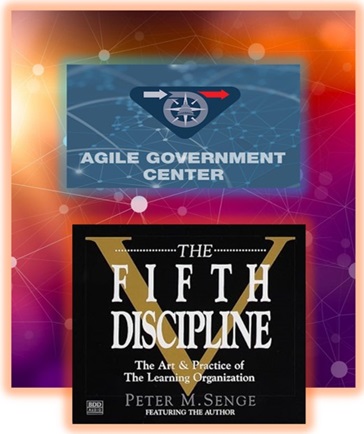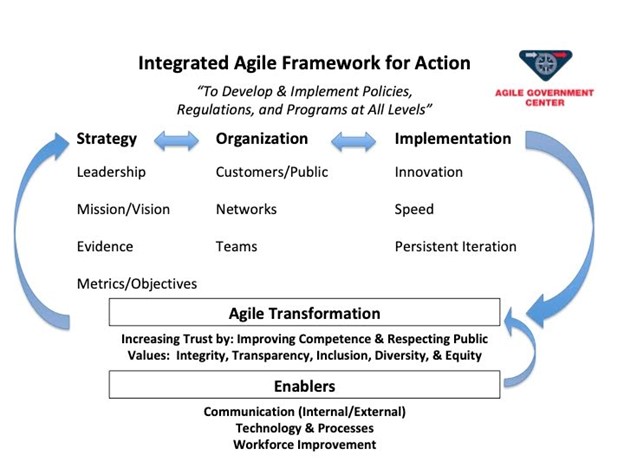
Peter Senge’s The Fifth Discipline and Agile Government

In July 2024, Michael Keegan wrote a thoughtful article on the work of Peter Senge, Leadership Insights from "The Fifth Discipline: The Art and Practice of the Learning Organization. This essay takes Michael’s insights and compares Senge’s five, “Disciplines” to the “Elements” of agile government and finds them very compatible. In fact, Senge was promoting agile before it was even invented.
Systems Thinking and Agile's Integrated Framework for Action
According to Senge: "Systems thinking is the cornerstone of the learning organization. It involves seeing the organization as a whole and understanding the interrelationships between its parts. This holistic approach helps leaders address root causes rather than just symptoms of problems.”[1]
The Agile Government Center approach to agile government embodies systems thinking by developing and using the Integrated Framework for Action as its implementation mechanism. The framework contains all of the elements of agile government and is characterized by the call for “simultaneous execution.”

Each element within this framework is connected to the other, and the entire system must operate in a coordinated simultaneous manner. For example, an organization’s clear mission and vision must be continually visible to all, including the customers and the public, as teams and networks are formed to shape and implement policies, regulations, and programs. Feedforward and feedback are continually integrated into new actions. In this framework, the principal outcome measure used is trust. The ability of agile government to increase trust by increasing competence and reflecting the positive values to the public feeds back into the ability of the organization to continue to improve service and meet public expectations.
Personal Mastery and Public Service Motivation
Personal mastery, as defined by Peter Senge, involves individuals continuously clarifying and deepening their personal vision, focusing their energies, and developing patience and seeing reality objectively.
As a complement to technical competencies, the first step in leading agile transformation in government involves assessing public service motivation among public servants. Noted author James L. Perry asserts that this encompasses four dimensions:
- Attraction to Policy Making (and Management)
- Commitment to the Public Interest
- Compassion
- Self-Sacrifice
Each of these dimensions is analyzed and compared to other practitioners in Perry’s 2021 work, Managing Organizations to Sustain Passion for Public Service . He includes a discussion of prosocial motivation and altruism which reflects the way public leaders can think about their own personal mastery.
Mental Models and Employing a Agile Mindset
Senge underscores that mental models are deeply ingrained assumptions, generalizations, or images that influence how we understand the world and take action. Bringing these models to the surface and scrutinizing them can improve our decisions and actions.
It is in fact a mindset shift and dovetails with how we define Agile Government, which is “A mindset framing actions designed to achieve government missions by developing and implementing policies, regulations, and programs applying agile government principles. This should increase trust in government by improving competence while promoting values people care about.”
A leading thinker in the importance of mindset, Professor Carol Dweck, distinguishes between a fixed and growth mindset. Dweck's scholarship on mindset informs our new course, Leading Agile Transformation [2]. , which looks to assist government leaders in creating and shaping new mental models that will help leaders to employ more effectively principles of agile government.
Shared Vision and Creating a Sense of Commonality
For Senge, a shared vision is not just an idea, but a force that is in people's hearts. It creates a sense of commonality that permeates the organization and gives coherence to diverse activities.
A core principle of agile government is for leaders to communicate a crystal-clear, focused mission that is easy to understand and convey at all levels. This communication should be continuous. The implementation of the American Recovery and Reinvestment Act (ARRA) provides an example of the importance of setting a clear vision and communicating that vision to achieve program success. The Act itself states a clear vision of job creation, assistance to individuals, existing and new investments in infrastructure, and stabilization of state and local budgets. This stated vision guided many small teams that implemented the act.
In writing about this effort, Ed DeSeve underscores the critical importance of having the president and vice president fully engaged in implementing this Act. [3]. This involved DeSeve being a full participant in both the Obama administrations daily staff meetings which him gave access to a vast network of influence.
In assessing the success of following this vision, Warren Buffett wrote,;"Well, Uncle Sam, you delivered...People will always second-guess your specific decisions; you can always count on that. But just as there is fog of war, there is fog of panic -- and, overall, your actions were remarkably effective.”[4].
Team Learning and Personal Mastery
Senge identifies the discipline of team learning, which involves aligning and developing the capacities of a team to create the results its members truly desire. It builds on personal mastery and shared vision but emphasizes the interaction between team members.
Another principle of agile government is to empowered cross-functional teams that create motivated, well-supported teams that work together, bringing diverse perspectives to solve problems. This principle follows the work of Stephen Denning who espoused the “Law of Small Teams" defining them as such: Agile practitioners share a mindset that work should, in principle, be done in small, autonomous, cross-functional teams working in short cycles on relatively small tasks and getting continuous feedback from the ultimate customer or end-user.
Summary
Though the principles and elements of agile government are a more recent development than the disciplines outlined in Peter Senge's ground breaking work, The Fifth Discipline: The Art and Practice of the Learning Organization, there is remarkable symmetry between these qualities. The disciplines described by Peter Senge are interrelated and mutually reinforcing similar to the proper use and application of agile principles. In this brief essay, we attempted to draw out the parallels between the disciplines described by Senge and the principles of agile government prompted by the Agile Government Center.
[1] The insights in each of the Five Disciplines are taken from https://www.businessofgovernment.org/blog/leadership-insights-fifth-discipline-art-and-practice-learning-organization-peter-m-senge, Quoted material is in italics
[2] This is a reference to the accredited course of the same name that is being offered by the Agile Government Center which is a partnership between the National Academy of Public Administration and the IBM Center for the Business of Government
[3] For a full discussion see https://www.businessofgovernment.org/sites/default/files/Managing%20Recovery.pdf
[4] https://www.governing.com/archive/gov-stimulus-obama-economy.html



